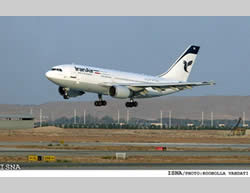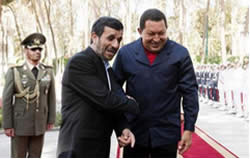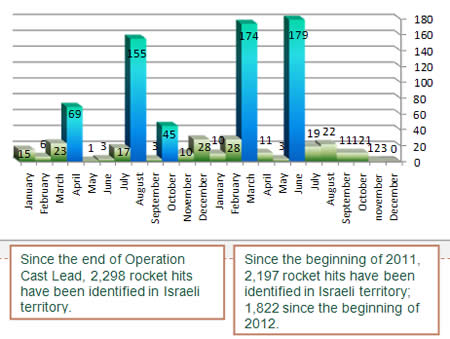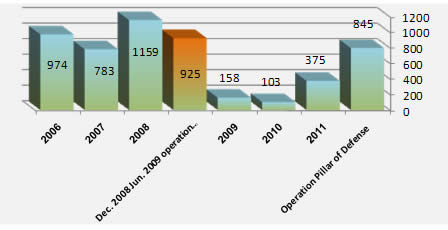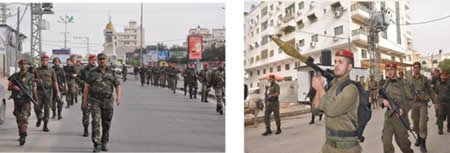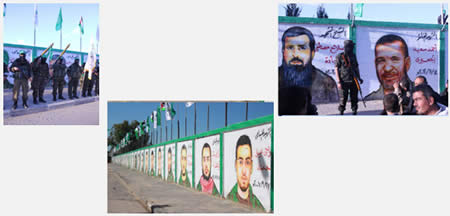Conference in support of Khuzestani Arabs convenes in Cairo during Foreign Minister Salehi’s visit to Egypt, provoking anger from Iran
|
A conference convened in Cairo to support the Arab minority in Khuzestan, a region in the southwest of Iran, is drawing criticism and anger from media and social networks in Iran. The conference, held in Cairo on January 10, was attended by representatives from the separatist movement for the liberation of Khuzestan, Muslim clerics, as well as several representatives from Egyptian political movements affiliated with the Islamic bloc, mainly Emad Abdel Ghafour, President Morsi’s advisor, who even expressed his support for the struggle of the Arab minority in Iran. Iranian websites that reported on the conference strongly criticized the government of Egypt for allowing it to convene at the time of Foreign Minister Salehi’s visit to Cairo. The Tabnak website personally attacked President Morsi, whom it referred to as a “second Mubarak” who follows the orders of his masters in London and Washington, and called on President Ahmadinejad to require a formal apology from Egypt as a condition for his participation in the summit of the Organization of the Islamic Conference. Iranian web users, too, expressed their anger over the conference in Cairo. They spoke out against manifestations of separatism in Iran, vigorously condemned the government of Egypt and President Morsi, and called for a strong reaction from Iran against Egypt. |
A conference convened in Cairo to support the Arab minority in the region of Khuzestan has drawn criticism and anger from media and social networks in Iran in recent days. The “Conference to Support the People of Ahvaz[1]” (the capital of Khuzestan Province, which gives the province its Arabic name) convened in Cairo last Thursday, January 10.
The conference was attended by representatives from the separatist movement for the liberation of Ahvaz, clerics from the Muslim world, representatives from Al-Azhar University in Cairo, as well as several representatives from Egyptian political movements affiliated with the Islamic bloc, mainly President Morsi’s advisor Emad Abdel Ghafour, who has links to the Salafi faction, and Egyptian parliament member Talaat Ramih. In Abdel Ghafour’s address to the conference, the president’s advisor expressed his support for the struggle of the Arab minority members in Iran and stated that, for them, Egypt will remain a refuge. He noted that Egypt’s support for the Arab residents of the region stems not from racial considerations but rather from its support for human dignity and justice, and stressed that, in terms of its area, the region is the equivalent of four Arab countries put together: Palestine, Lebanon, Syria, and Jordan.
Sabbah al-Musawi, one of the leaders of the movement for the liberation of Ahvaz and co-organizer of the conference, spoke about the “Iranian occupation” of the Ahvaz region and thanked the government of Egypt for holding the conference. He accused Iran of trying to change the Arab identity of the region and pull it apart from the Arab world. Saudi cleric Muhammad al-Urayfi delivered a speech saying that the Arab and Muslim countries need to extend assistance to “the Arab brothers in Ahvaz” and accused Iran of using the oil resources of the region to cause a rift and provoke wars among Muslims.
Iranian websites attack the government of Egypt over the conference
This weekend the Tabnak website strongly criticized the fact that the conference was held in Cairo during Iranian Foreign Minister Ali-Akbar Salehi’s visit to Egypt. A report published by the website on January 11 said that, while the foreign minister was meeting with top Egyptian officials in Cairo, a group of “terrorists and separatists calling themselves Iranian Arabs” was holding a conference in cooperation with Morsi’s government to discuss the secession of the Khuzestan region from Iran and “the occupation of the Arab land of Ahvaz by the Persians”. The website referred to Sabbah al-Musawi as a “known spy with links to England”.
The website noted that, while the management of Al-Azhar University denied having anything to do with the conference, the presence of an Egyptian parliament member for the Muslim Brotherhood at the conference is a reflection of the movement’s new policy against Iran. Iran must keep its eyes and ears open in light of the events, Tabnak said, rather than looking the other way from the extremist members of the Muslim Brotherhood who seek to dominate the region and fulfill their objectives.
The website personally attacked President Morsi, saying that, at best, he is a “second Mubarak”, at worst, he plays the role fulfilled by Iraq’s President Saddam Hussein against the Iranian people. President Morsi, whose path to the presidency of the republic is perfectly clear, has no other option but to follow this path, which is based on his obedience to his masters in London and Washington, the website said.
According to Tabnak, despite the limitations imposed on Iran when it comes to its ability to contend with the new Egyptian regime, it cannot turn a blind eye to the conduct of President Morsi and his supporters. The website called on President Ahmadinejad to require a formal apology from the government of Egypt as a condition for his participation in the summit of the Organization of the Islamic Conference, and to stay in Egypt for no more than a few hours.
The daily Javan also strongly criticized the government of Egypt in the wake of the conference. In an editorial titled “Desperate nationalism and passive tribalism in Egypt”, published on January 13, the daily expressed amazement that top Egyptian officials allowed the conference to convene while Salehi was visiting Cairo, despite the perfectly obvious British-Israeli nature of the confrence and its objective to undermine the power of the Muslim world and split it along ethnic, racial, and religious lines.
If the conference was convened deliberately, the article said, then it is an indication of desperate nationalism in the Egyptian government, which gives rise to suspicions that it is involved in a British-Israeli scenario. In this case, the uprising in Egypt is best defined as a “coup” staged by a group that wished to replace Mubarak and Sadat, rather than as a “revolution”. If the conference was not convened deliberately, then it is quite regrettable that the senior officials in Egypt are this negligent.
The daily condemned the cooperation between the Muslim Brotherhood of Egypt and the Wahhabiyya school of thought in Saudi Arabia. The Muslim Brotherhood knows that the aim of the Wahhabis is to work in service of the British and the Zionists and instigate religious conflicts in the Muslim world. If the Muslim Brotherhood falls into this trap, Egypt may be pushed to division, civil war, and everything that makes its enemies happy. How is it possible that the United Arab Emirates, whose history goes back a mere 70 years, and the other tribal governments of the Persian Gulf dictate a strategy for Egypt, with its glorious history? How is it possible that the Muslim Brotherhood government has become a partner in the humiliating policy of the United States and Israel as a result of political and economic pressure as well as security and military warnings? If the new Egypt is the product of the founders of the Muslim Brotherhood, Sayyid Qutb and Hassan al-Banna, then its logical behavior should manifest a struggle against the colonialist policy of Britain, America, and the Zionists, rather than coordination with the Arab reactionaries and the tribal tyrannies.
The news agency of the Iranian Ahlul Bayt association also spoke out against the conference convened in Cairo, saying that, instead of thinking about convening such a “funny and divisive” conference, Al-Azhar University and the political parties in Egypt had better turn their attention to their Arab neighbor, Palestine, which has been under Israeli occupation and oppression for 60 years and is ignored by the Arab countries, including Egypt (www.abna.ir, January 10).
Reactions from web users
Iranian web users, too, expressed their anger over the conference in Cairo. A number of them called for a strong reaction from Iran against Egypt. One web user demanded tough action against the Salafis in Egypt, Palestine, and the Arab world, saying that these “infidel Salafis” must not be allowed to hurt the Shi’ites simply for fear of compromising the unity of Muslims.
Another web user called for a struggle against any person, nation, or separatist group trying to separate even a small part of Iran’s sacred land, for whose sake thousands of people spilled their blood. A web user who referred to himself as an “Iranian Azeri” wrote that separatists have no place in Islamic Iran, and that they serve the interests of the West and its conspiracies. The Iranian people and government must not remain silent and show mercy to the separatists and the Arab leaders that act in accordance with the policy of the West, the web user wrote.
Yet another web user called on the government to work for a change in the population make-up of Khuzestan. Residents of Iranian descent should be transferred to any city where there is talk of separatism and race so that no one can talk about race anymore. In response, a web user replied that all nations and races need to be respected. He went on to say that changing the population make-up in the region is a “Zionist idea”, and that such an idea will lead to the establishment of small cities in Iran’s border regions for the sole purpose of changing their population make-up.
Another web user argued that there is no reason for Iran to act politely to Egypt just because of the revolution that took place in that country. Why does Iran act politely to a country like Egypt and treats the United States, an economic and military superpower, as an enemy? Still another web user noted that if the government of Egypt is challenging Iran’s territorial integrity, it needs to be answered in accordance with the directive issued by Supreme Leader Ali Khamenei, who formerly stated that Iran will hit the interests of any country that will threaten its territorial integrity.
A number of web users lashed out against the government of Egypt and President Morsi. Egypt depends on the Wahhabis, one web user wrote, and there is no question about the hostility that the Salafis and Wahhabis have for Iran. The sole desire of Egypt and the other Arab countries is to hurt Iran, and everyone knows that Morsi’s statement during his meeting with Foreign Minister Salehi, in which he expressed friendship towards Iran, is a lie. One of the web surfers defined Morsi as “dangerous”, while another argued that Egypt under Mubarak’s leadership was closer to Iran than it currently is under Morsi’s leadership. Morsi became president thanks to the support of the West, one web user wrote, and the Iranians do not believe his allegedly Islamic behavior.
The region of Khuzestan: the center of the Arab minority in Iran
Khuzestan Province, in the southwest of Iran, is home to the Arab minority, making up about three percent of Iran’s population. The region’s tremendous importance derives from its strategic location on the Persian Gulf coast, its oil reserves, and the important oil facilities located there. The Arab population of Khuzestan has its origins in Arab migrants who arrived in the region following the Muslim conquest in 641. The migration persisted throughout the next centuries and significantly increased starting in the 16th century.
In the 20th century the Iranian regime attempted to weaken the pronouncedly Arab ethnic identity of the province by transferring Iranian citizens of Persian descent to the region. When Iran consolidated its control over the region following a successful military campaign waged by the authorities in 1924, the name of the province was officially changed from Arabestan, as it had been called since the 16th century, to Khuzestan, while Persian became the language of instruction in the province’s schools and the official language of administration. In the late 1950s Iran became increasingly concerned over the growing influence of Arab nationalism on the Arab residents of the region. This period also saw the emergence of the Arabistan Liberation Front (established in 1958), which called for a separation of the province from the Iranian state and its handover to Arab control.
After the Islamic revolution of 1979, a number of demonstrations took place in the province calling for a limited autonomy in the region, increasing its share in the oil revenues, teaching Arabic as a first language, and giving preference to Arabs in local positions. However, these demonstrations did not evolve into a significant challenge for the regime, and nor did the outbreak of the war with Iraq in 1980 spur the Arab resistance movement in the region.
[1] ‘Ahvaz’ is sometimes transliterated as ‘Ahwaz’, which reflects its Arabic pronunciation.



















